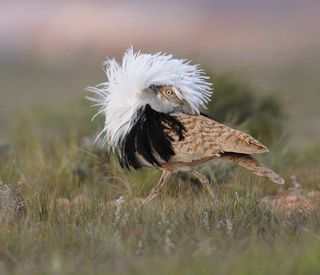Sexy Show-offs Burn Out Young

Being the prettiest bird of them all may come with a downside: early sexual burnout, a new study finds.
Male houbara bustards, found in deserts in the Southern Hemisphere, spend up to six months every year trying to charm female houbara bustards with elaborate feather displays. The flashiest male birds that spend the longest stints posturing also have the highest-quality sperm, the new study shows, but things go downhill fast for the showiest houbara bustards, sexually speaking.
"This is the bird equivalent of the posers who strut their stuff in bars and nightclubs every weekend," study researcher Brian Preston of the University of Burgandy in France said in a statement. "If the bustard is anything to go by, these same guys will be reaching for their toupees sooner than they'd like." [Album: Animals' Dazzling Headgear]
Putting on a show
Instead of impressing the ladies via gelled hair and bottle service, male houbara bustards "erect an ornamental 'shield' of long white feathers in front of them as they begin to run at high speed, often circling a rock or bush," Preston and his colleagues wrote online Aug. 1 in the journal Ecology Letters. The birds finish the performance by flaring black-and-white feathers covering parts of their bodies, and a series of subsonic calls. [See an image of the display ]
This goes on for 18 hours a day.
Such energy-intensive mating displays cost males about 10 percent of their body mass over the mating season. The new analysis of 158,799 houbara bustard ejaculations finds that the displays eventually take their toll.
Sign up for the Live Science daily newsletter now
Get the world’s most fascinating discoveries delivered straight to your inbox.
Burn out or fade away?
The ejaculate samples, collected from captive birds, showed that the most enthusiastic suitors — those that spend the most time performing — have the best sperm quality in the first six years of their lives. They have higher sperm production rates and fewer malformed sperm cells, and the sperm cells they produce are more active compared with older birds.
But these showy suitors quickly burn out. Although they display their feathers as vigorously as ever in old age, they ejaculate up to 85 percent less sperm. The sperm they do have left are less active and more malformed than the sperm of less showy birds — and the flashy birds' decline starts sooner.
For example, a bird that displayed for 30 days a year might have 79 percent normal sperm at the age of 15. A bird that showed off 180 days a year, on the other hand, could expect only about 73 percent normal sperm
The study might help explain how senescence, or biological aging, evolved, Preston said. Reproductively speaking, he said, the cost of living hard is burning out young.
You can follow LiveScience senior writer Stephanie Pappas on Twitter @sipappas. Follow LiveScience for the latest in science news and discoveries on Twitter @livescience and on Facebook.

Stephanie Pappas is a contributing writer for Live Science, covering topics ranging from geoscience to archaeology to the human brain and behavior. She was previously a senior writer for Live Science but is now a freelancer based in Denver, Colorado, and regularly contributes to Scientific American and The Monitor, the monthly magazine of the American Psychological Association. Stephanie received a bachelor's degree in psychology from the University of South Carolina and a graduate certificate in science communication from the University of California, Santa Cruz.
Most Popular






